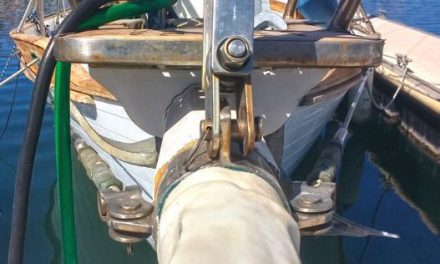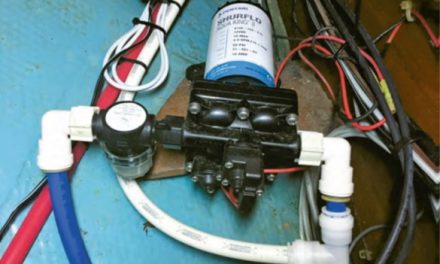A clever solution for raising a mast on a small boat
Issue 155: March/April 2024
I have a renovated/repurposed 17-foot Thistle trailer-sailer named Transmogrifier for daysailing and beach cruising (see page 36 for the full story). The mast is light enough that I am able to raise it manually once the butt is secured in the tabernacle, which is good, as I typically sail solo.

The finished grabber with lanyard is easy to make and incredibly functional.

The grabber is in place, with the forestay secured to the tensioning lever inside the bow.
The boat’s shrouds are led slightly aft and become taut as the mast is raised, which keeps it from falling off to either side. When the mast is up, there is only a slight rake, so there is not a great tendency to fall aft. However, the thought of losing control of the spar and having it fall before I have the forestay connected makes my blood run cold. Using the jib halyard to support the mast is a common solution, but my boat has wire halyards with a somewhat cumbersome winch arrangement, making this less suitable for me.
The problem is accentuated a bit on my boat because to connect the forestay, the forked swage has to be passed through a hole in the breasthook and then connected to the tensioning device with a pin. While I have eased pin installation by replacing the standard clevis pin with a quick lock pin — the type with a plunger that releases the detent ball — I still have to hold tension on the forestay while inserting it. Since the stay is only 3/32-inch and the swaged fork is low profile, there is not much to grab onto. If I lost my grip on it, I doubt I would be able to save the mast. I needed something to get a better grip while leaving both hands free to align and insert the pin.
The solution was inspired by a chain grabber, which is commonly used with anchoring arrangements on larger boats. I adapted the simple slotted fork design to my needs. I bent a 3-inch piece of 1/8-inch x ½-inch aluminum flat stock into a U shape at one end. I used a metal cutting wheel in a grinder to cut a slot of the appropriate width, then filed the edges to a smooth, round shape. Drilling a ¼-inch hole at the other end allowed me to attach a lanyard that I can loop around my wrist. Finally, I made a slight bend in the middle to make the piece easier to grasp.

When tension is applied via the lanyard, the author’s fingers are free to manipulate the swage and pin it into place.
Now, once the forestay is passed through the hole in the breasthook, it is easily secured with the grabber. Having adjusted the length of the lanyard, I can then apply tension to the forestay with my wrist while leaving my fingers free to align and insert the pin. Once the pin is in place, the forestay tensioning lever is flipped and … done! This simple little device has made mast raising much less stressful.
John Churchill grew up a boat-crazy kid in Indiana. He built a raft at age 6, sailed Snipes as a teenager, and worked his way toward salt water and bigger boats. He has sailed a Cape Dory 26 singlehanded to Bermuda and back, and a Bristol Channel Cutter transatlantic with his father. Now in Florida, John sails Nurdle, a Bristol 35.5 (and former repo) that he’s rehabbing for extended post-retirement cruising.
Thank you to Sailrite Enterprises, Inc., for providing free access to back issues of Good Old Boat through intellectual property rights. Sailrite.com





